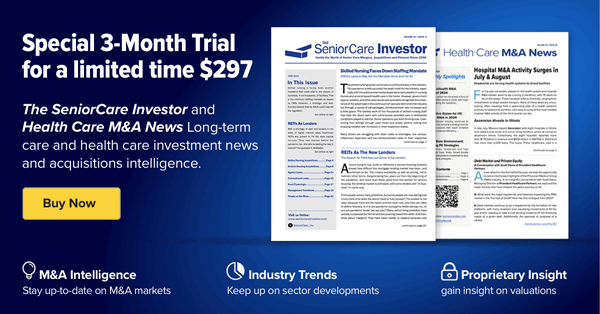Examining the healthcare M&A market in 2019 may seem like a strange endeavor since, for many of us, it feels like an entirely different era. But there’s value in analyzing how the healthcare M&A market in August 2020 differed from the one in August 2019, even if they both represent radically different times. The snapshot of the past will help us see how the market has changed, identifying new trends and creating a roadmap for future acquisitions.
In August 2019, there were 149 transactions publicly announced, with $28.03 billion in disclosed spending, according to Deal Search Online. Transactions in the services sectors comprised the majority of activity in August 2019 at 68%, but only 23% of announced spending. The Long-Term Care sector had the most announced transactions at 42 deals, with Physician Medical Groups (PMG) and eHealth tied at second with 20 reported deals each.
In other words, healthcare M&A for August 2019 mirrored nearly every other month in 2019. Investors, especially private equity, sought targets in the services sectors, but targets in the technology sectors carried the highest dollar values.
Fast forward to August 2020, and some trends have remained consistent, but there are others worth highlighting. Only 107 deals were announced in August this year, and deal volume in the services sectors still topped that of the technology sectors, but demand waned, with only 66 services deals announced in August (61% of total volume).
The decline of M&A activity in the Long-Term Care sector is arguably the most dramatic change in the industry. Throughout 2018 and 2019, deal making in Long-Term Care soared, and made up the bulk of activity each month. However, 2020 has looked much different. In August this year, there were just 21 deals publicly announced, a 52% decrease from August 2019. The economic ramifications stemming from social distancing and quarantine measures took a toll on seniors housing and care M&A. Although investor interest in skilled nursing facilities hasn’t completely vanished, transactions for assisted living and CCRCs are on the rise, most likely because they haven’t been hit as hard by the pandemic.
Interest in physician practices has also declined year over year, dropping 55% compared with August 2019. Much of that has to do with the pause in elective surgeries as part of the response to COVID-19 and the uncertainty around that, but the numbers only tell part of the story.
PMG deals now show a greater diversity in subsectors, especially as hospitals continue to outsource more services to deal with the effects of COVID-19. In August 2019, investors primarily targeted dermatology and dental practices, but in 2020, we’re now seeing interest for practices specializing in orthopedics, anesthesiology and ophthalmology.
However, some targets are seeing increased demand, such as diagnostic companies, and it’s driving up deal volume in the Laboratories, MRI & Dialysis sector, rising 250% compared with August 2019. After Thermo Fisher Scientific Inc. (NYSE: TMO) and QIAGEN N.V. (NYSE: QGEN) dropped their $11.4 billion merger, the latter acquired NeuMoDx Molecular, Inc. for $234 million. NeuMoDX will boost QIAGEN’s COVID-19 testing capabilities, as well as other tests for infectious diseases.
In the technology sectors, eHealth has been the primary focus for investors, with 21 deals in August this year, the highest total of any sector. COVID-19 has increased the demand not just for telehealth and telemedicine providers, but also for companies offering revenue cycle management (RCM) services and patient engagement platforms to help hospitals shoulder the weight of the pandemic. Of the six RCM companies acquired in August, all but one focused on hospitals.
We can’t talk about healthcare M&A without talking about private equity. In August 2019, private equity and their sponsored companies announced roughly 24% (36 deals) of all transactions for the month, with a total $10.18 billion in announced spending. Physician Medical Groups, Long-Term Care and Behavioral Health Care saw the most PE firm activity.
In August 2020, activity from PE firms dropped slightly, to 22% (24 deals), with only $405.2 million in announced spending. Although PE firms continue to acquire physician practices, firms announced just as many transactions in the eHealth sector this August. However, PE firms also treaded into more unusual territory this August, such as the Pharmaceutical sector and the wound care market. With the services sectors under significant financial pressure, it’s no surprise to find PE looking for other avenues to explore, to capitalize on new market conditions.


